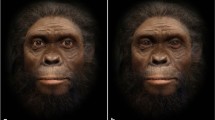Abstract
“The eyes are the window of the soul” is a staple cliché in many cultures, but is there any truth to this concept, of any potential importance in the forensic realm? The present study addressed this question in two experiments. It was shown that observation of the eyes and ocular regions of normal control individuals, and of serial killers, enabled average respondents to distinguish these individuals clearly in terms of trustworthiness, likability, and general “goodness.” In both experiments, and based on nothing but this observation, serial killers were consistently rated lower on all three indices. No sex or individual differences were observed in this pattern of results. These findings are consistent with current evolutionary and cognitive theory, and may highlight the importance of the perception of defendants by witnesses and jurors in criminal proceedings.
Similar content being viewed by others
References
Bradley MM (2000) Emotion and motivation. In: Cacciopo JT, Tassinary LG, Berntson GG (eds) Handbook of psychophysiology, 2nd edn. Cambridge University Press, Cambridge, pp 602–642
Braine C (1970) New finds on the Swartkraans australopithecine site. Nature 225:112–119
Brues AM (1977) People and races. Macmillan, New York
Butler AB, Hodos W (1996) Comparative vertebrate neuroanatomy. Wiley-Liss, New York
Carlson EB, Putnam FW (1993) An update on the dissociative experiences scale. Dissociation 6:16–27
Darwin C (1872) Expression of the emotions in man and animals. Murray, London
Ekman P, Friesen WV (1986) A new pan-cultural facial expression of emotion. Motiv Emot 10:159–168
Frazier JG (1890) The golden bough. Avenal, New York
Hickey EW (1997) Serial murderers and their victims. Wadsworth, Belmont, CA
Jolly A (1972) The evolution of primate behavior. Macmillan, New York
Keats J (1819) La belle dame sans merci. In: Quiller-Couch A (ed) (1940), The Oxford book of English verse. Oxford University Press, New York
Lambroso C (1876, reprinted 2006) Criminal man. Duke University Press, Durham, NC
Lewis-Williams D, Pearce D (2005) Inside the Neolithic mind. Thames and Hudson, London
Mayor A (2000) The first fossil hunters. Princeton University Press, Princeton, NJ
Orians GH (1998) Human behavioral ecology: 140 years without Darwin is too long. Bull Ecol Soc Am 79:15–28
Orians GH, Heerwagen JH (1992) Evolved responses to landscapes. In: Barkow JH, Cosmides L, Tooby J (eds) The adapted mind: evolutionary psychology and the generation of culture. Oxford University Press, New York
Prothero DR (2006) After the dinosaurs. Indiana University Press, Bloomington, IN
Sharps MJ (2012) Eyewitness to the paranormal: the experimental psychology of the “unexplained.”. Skeptical Inquirer 36:39–43
Sharps, M.J., & Herrera, M. (2016) The eyes really do have it: attribution of violent potential from facial observation. Paper presented at the meeting of the Society for Police and Criminal Psychology, Austin, TX
Sharps MJ, Liao SW, Herrera MR (2016) Dissociation and paranormal beliefs: toward a taxonomy of belief in the unreal. Skept Inq 40:40–44
Sharps MJ, Villegas AB, Nunes MA, Barber TL (2002) Memory for animal tracks: a possible cognitive artifact of human evolution. J Psychol 136:469–492
Turner A (1997) The big cats and their fossil relatives. Columbia University Press, New York
Acknowledgments
The authors wish to thank Richard Herrera for his expertise and assistance in generating the digital stimuli employed in this study.
Author information
Authors and Affiliations
Corresponding author
Ethics declarations
This article is based entirely on original work conducted by the authors. Full ethical approval per University and OHARP regulations was obtained from the appropriate CSU Institutional Review Board in advance, and the study was IRB-designated “minimal risk.”
Conflict of Interest
The authors declare that they have no conflict of interest.
Informed Consent
Full informed consent, in writing, was received from all respondents and the completed informed consent forms are stored separately from the data under locked conditions, as per American Psychological Association regulations.
Rights and permissions
About this article
Cite this article
Sharps, M.J., Herrera, M.R. The Eyes Really Do Have It: Attribution of Character in the Eyes of Killers. J Police Crim Psych 34, 105–108 (2019). https://doi.org/10.1007/s11896-018-9271-3
Published:
Issue Date:
DOI: https://doi.org/10.1007/s11896-018-9271-3




